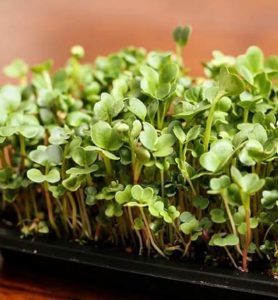Although you can grow microgreens in your backyard, one downside is transboundary plant pests and diseases that ravage your gorgeous plants and delicious vegetables. A regular inspection of your microgreens can alert you to these natural enemies before they become a significant problem and allow you to prevent significant damage. Here you will find a list of common crop pests and plant diseases and how to identify them.
Common Microgreen Diseases
 Botrytis: This is a fungus that causes a grey mold on leaf surfaces. It flourishes in cool, moist weather.
Botrytis: This is a fungus that causes a grey mold on leaf surfaces. It flourishes in cool, moist weather.
What to do: Plant parts that have become affected must be removed, you should avoid nighttime watering, and you should not spray water on the plant. Keep plants well-ventilated. For fungicide recommendations, contact your Cooperative Extension Service.
Damping Off: When starting plants from seed, this is one of the most common problems. Seedlings appear healthy at the start and then suddenly wilt and die for no apparent reason. A fungus that causes damping-off is active when conditions are moist, and temperatures are above 68 degrees Fahrenheit. It indicates either too much water or too much nitrogen fertilizer in the soil.
What to do: Do not over-water your seedlings, avoid over-fertilizing, thin out seedlings to avoid overcrowding, and always wash away plant residue in soapy water along with a ten percent bleach solution after using containers.
Root Rots: Many pathogens can cause root rots of seedlings and mature roots.
What to do: Plant different crops every few years so that you are not planting the same crops over and over. An infected host plant should be removed and disposed of. Drainage must be excellent in your soil. Find out what your Cooperative Extension Service has to offer.
Sclerotinia: Also known as white mold, this fungus looks like a web crawling across the growing medium. Plants can be killed by it when it climbs onto them.
What to do: Air circulation should be increased to decrease humidity. Overcrowding of seedlings is not recommended. It is essential to clean seed starting supplies before reusing them.
Yellow Foliage: The plant may lack light, be overcrowded, or possess low soil nutrients.
What to do: The room should be adequately lit and ventilated. When yellowing is evident, apply a light fertilizer application.
Common Pest Species and Cultural Problems for Microgreens
A wide range of invasive pests can damage a plant in various ways, including defoliation or root tunneling. You can tell if insects damage a plant if it is stunted or has damaged leaves or fruits. Check the underside of leaves and the base of the microgreen for insects. Dusk and early morning are usually the best times to observe insects feeding.
Aphids: Sucking insects that are greenish, red, black, or peach-colored can spread disease outbreaks when their mouthparts feed on the underside of leaves. The sticky residue they leave on foliage attracts ants.
What to do: Aphids can be controlled by introducing or attracting natural predators into your gardens, such as lady beetles and wasps. It is also possible to spray them with insecticidal soap, use a pheromone trap or wash them off with a strong detergent.
Deer: They can eat plants down to the ground.
What to do: Use a deer repellent or a physical barrier around young plants.
Flea Beetles: They are small, hopping insects that feed on foliage.
What to do: Plant crops of a different family every few weeks. You can prevent young foliage from being damaged by using floating row covers.
Rabbits: Chew on leaves of plants. The damage is the same as the one caused by deers but usually not as severe.
What to do: Spray hot pepper wax or use rabbit repellent.
Slugs: They damage foliage by eating it or leaving large holes in it. They leave slime trails behind, feed at night, and are usually a problem in damp weather.
What to do: If possible, pick by hand at night. You can use cornmeal or beer to attract slugs to traps. Use a cup or bowl to trap slugs; use something with side slopes so that slugs are unable to get back out once they’ve been trapped. Pour about 34% of the beer into the bowl, and let it sit overnight. The following day, the bowl can be emptied of drowned slugs so that the birds can eat them. You can make cornmeal traps by putting a tablespoon or two of cornmeal in a jar and placing it on its side near the host plant. Slugs are attracted by the scent but are unable to digest it, so that they will die. If you have diatomaceous earth or coffee grounds on hand, you can use them as barriers around your plants. This is not something they can crawl over.
Additional FAQs
How are microgreens different from sprouted seeds?
Seedlings with several sets of leaves are microgreens, which are 2- to 4-week-old plants. Sprouting seeds are seeds that sprout quickly and are used soon afterward.
What are the best methods for using microgreens?
Many dishes benefit from the flavor, texture, color, and nutrients that microgreens offer. You can add them to sandwiches, fresh salads or use them as a garnish.
Can I grow microgreens inside my home?
As long as you give them adequate light, they can grow indoors. They are also ideal for hydroponics.
Are heat pads necessary for growing microgreens indoors?
No, your seeds will sprout at most house temperatures, and a heating pad may cause them to grow too quickly if you leave them on it after they sprout.
What are the symptoms of a bacterial or fungal disease?
Fungal diseases can often be spotted by visible mold, orange pustules, and round leaf spots which can affect plant health.

